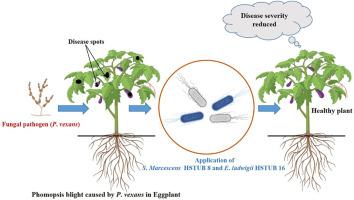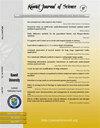Biorational phomopsis blight management in eggplants using two bacteria isolated from the eggplant rhizosphere
IF 1.1
4区 综合性期刊
Q3 MULTIDISCIPLINARY SCIENCES
引用次数: 0
Abstract
Phomopsis blight, caused by Phomopsis vexans, is a major eggplant disease that significantly reduces output in Bangladesh. In order to produce a new fungicide, 210 bacterial strains were isolated from the rhizosphere of eggplants. Phylogenetic trees using 16S rRNA gene sequences of HSTUB 8 and HSTUB 16 revealed a close relationship with Serratia marcescens and Enterobacter ludwigii, respectively. Among the isolates, HSTUB 8 (Serratia marcescens) and HSTUB 16 (Enterobacter ludwigii) showed the maximum inhibition zones (1.6 cm and 0.9 cm, respectively) against P. vexans in vitro. In field conditions, basal application of pea bran-based formulated HSTUB 8 and HSTUB 16 followed by spraying of a suspension of both the bacteria exhibited a maximum reduction of disease incidence (64.70 %) and severity (77.27 %) over the control. The same bio-fungicide also resulted in enhanced growth and production, such as branches per plant (75.05 %), plant height (32.28 %), fruits/plant (404.54 %), firmness of fruits (57.42 %), and total soluble solids (66.67 %) over the control. Basal application of pea bran-based HSTUB 8 followed by spraying of the suspension of the same bacterium yielded a higher total phenol content in the fruits (56.86 mg/100 g) as compared to the control (24.74 mg/100 g). All gathered data strongly indicate that the pea bran-based formulated bio-fungicides composed of S. marcescens HSTUB 8 and E. ludwigii HSTUB 16 can be used for both the production of high-quality fruits and the management of phomopsis blight disease of eggplants at field conditions in an effective and eco-friendly way.

利用从茄子根际分离的两种细菌对茄子进行生物防治
由黄瓜枯萎病(Phomopsis vexans)引起的茄子枯萎病是一种严重影响孟加拉国茄子产量的主要病害。从茄子根际分离了210株细菌,制备了一种新型杀菌剂。利用HSTUB 8和HSTUB 16的16S rRNA基因序列进行系统进化树分析,结果显示HSTUB 8和HSTUB 16分别与粘质沙雷菌和路德维希肠杆菌亲缘关系密切。其中HSTUB 8(粘质沙雷氏菌)和HSTUB 16(路德维希肠杆菌)对vexans的体外抑制区最大,分别为1.6 cm和0.9 cm。在田间条件下,先施用豌豆膜配制的HSTUB 8和HSTUB 16,然后喷洒两种细菌的悬浮液,与对照相比,发病率(64.70%)和严重程度(77.27%)最大程度降低。与对照相比,同一生物杀菌剂也促进了植株的生长和产量,如单株枝数(75.05%)、株高(32.28%)、果实/株(404.54%)、果实硬度(57.42%)和可溶性固形物总量(66.67%)。基础施用以豌豆膜为基础的HSTUB - 8,然后喷洒相同细菌悬浮液,果实中总酚含量(56.86 mg/100 g)高于对照(24.74 mg/100 g)。综上所述,由粘质S. marcesens HSTUB 8和ludwigii E. HSTUB 16组成的以豌豆膜为基础的配方生物杀菌剂,既可用于优质果实的生产,又可用于茄子白叶枯病的田间有效环保防治。
本文章由计算机程序翻译,如有差异,请以英文原文为准。
求助全文
约1分钟内获得全文
求助全文
来源期刊

Kuwait Journal of Science
MULTIDISCIPLINARY SCIENCES-
CiteScore
1.60
自引率
28.60%
发文量
132
期刊介绍:
Kuwait Journal of Science (KJS) is indexed and abstracted by major publishing houses such as Chemical Abstract, Science Citation Index, Current contents, Mathematics Abstract, Micribiological Abstracts etc. KJS publishes peer-review articles in various fields of Science including Mathematics, Computer Science, Physics, Statistics, Biology, Chemistry and Earth & Environmental Sciences. In addition, it also aims to bring the results of scientific research carried out under a variety of intellectual traditions and organizations to the attention of specialized scholarly readership. As such, the publisher expects the submission of original manuscripts which contain analysis and solutions about important theoretical, empirical and normative issues.
 求助内容:
求助内容: 应助结果提醒方式:
应助结果提醒方式:


